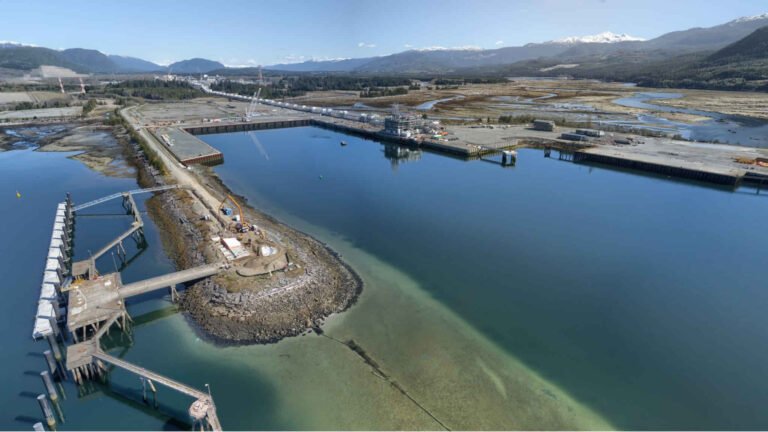LNG Canada Nears Operational Milestone at Kitimat Terminal
LNG Canada, a major joint venture comprising Shell, Petronas, PetroChina, KOGAS, and Mitsubishi, is on track to commence operations by mid-2025 at its expansive liquefied natural gas (LNG) export terminal in Kitimat, British Columbia, Canada.
Recently, a significant milestone was achieved with the completion of the final weld on the first production train at the Shell-led LNG Canada project. This project, deemed one of the largest energy endeavors in Canadian history, has seen remarkable progress thanks to the efforts of Fluor and JGC Corporation, the entities forming the JGC-Fluor joint venture responsible for various aspects of the megaproject.
In preparation for the start of operations, LNG Canada is scheduled to receive an LNG cargo in early April 2025 at its marine terminal in Kitimat for equipment testing. This delivery is crucial for the safe start-up and commissioning process that is currently underway, aiming to achieve the first cargo by the middle of 2025. It’s important to note that LNG Canada has not yet commenced operations or begun producing LNG.
While an LNG carrier will deliver liquefied natural gas for testing and commissioning purposes, additional import LNG shipments to the LNG Canada facility are not expected.
“Most modern LNG projects receive LNG in their commissioning and start-up processes. Introducing LNG to our facility is required to cool our LNG tank and operate equipment at cryogenic (low temperature) conditions in early testing,” explained a representative from the Shell-led consortium.
Safe Shipping Procedures
As part of the operational protocols, the LNG carrier will notify Canadian authorities, including Transport Canada, Canada Border Services Agency, and Canadian Coast Guard, 96 hours before its arrival at the Triple Island pilot station in Prince Rupert. A team of BC Coast Pilots will board the LNG carrier at the pilot station to guide it to the LNG Canada marine terminal in Kitimat, covering a distance of 159 nautical miles.
During the transit, an escort tug from HaiSea Marine, a joint venture between the Haisla Nation and Seaspan, will accompany the LNG carrier. Upon reaching Kitimat, HaiSea Marine harbor tugs will assist the carrier in berthing at the LNG Canada marine terminal jetty for the LNG transfer process.
Once ashore, LNG from the carrier will be delivered via the LNG Canada loading line to cool down pipework and the project’s LNG storage tank. The discharge process may take several weeks to complete before the LNG carrier departs Canadian waters under the guidance of BC Coast Pilots.
LNG Canada emphasized its commitment to upholding the highest safety standards and industry best practices to protect local communities and the environment, both on land and at sea. Collaboration with local authorities and stakeholders is prioritized to monitor and mitigate any potential impacts to the environment, marine life, and nearby communities.
Project Overview and Future Prospects
The construction of the LNG Canada project commenced in 2018 with an initial production capacity of 12.7 metric tons (14 million tons) of LNG per year, positioning Canada as a significant player in the global LNG market. The project has also contributed significantly to the local economy, with contracts and subcontracts exceeding $4.7 billion, including substantial investments in Indigenous-owned and local businesses.
A notable $500 million contract has been awarded to HaiSea Marine to provide harbor and escort tugboat services using their fleet of environmentally friendly vessels. The project infrastructure includes LNG processing units, storage tanks, rail yards, water treatment facilities, and flare stacks, with plans to expand production capacity to 14 million tons per annum (mtpa) initially, potentially doubling with future expansions.
As Canada’s first large-scale LNG export facility upon completion, LNG Canada in Kitimat is set to lead the country’s LNG export projects. With multiple projects in various stages of development, Canada is poised to make significant investments in LNG infrastructure, positioning itself as a key player in the global LNG market.

